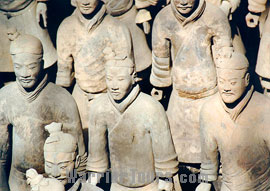- Pit 1, 2 & 3 of Terracotta Army
Pit 1, 2 & 3 of Terracotta Army

![]() Pit 1
Pit 1
Pit 1, discovered in May 1974, the largest of the three, is in the form of an earth and timber lined rectangle. It is 210 meters (230 yards) from east to west, 62 meters (68 yards) in width and covers a total area of 12,600 square meters (14,350 square yards). The depth fluctuates between 4.5 and 6.5 meters. Five entries were found on each side. Those on the eastern side are the main entrance. Eleven parallel passageways stretch through the vault from east to west. A section of 960 square meters has been fully excavated and marked out as the main attraction of the museum. A three-line vanguard of 204 tunic-infantrymen stands in the front. Immediately behind them are 36 rows of armed soldiers with war chariots at various intervals. A single column of soldiers face north and south flanking the main body of men, while a further column face west as the rear. The functions of the armed soldiers are recognizable by the weapons they carried which include spears, battle-axes, halberds and crossbows.
Typical figures include: An armor clad general, armored soldiers, tunic-infantrymen and war chariots.

![]() Pit 2
Pit 2
Located 20 meters (66 feet) to the north of Pit 1, Pit 2 is a vertically upturned 'L' shape and consists of four sections.
In the first section, the easternmost position, a cache of archers lay in wait. One hundred and sixty heavily armed kneeling archers lined in four intervals are surrounded by one hundred and seventy two standing archers. The formation greatly enhances the defensive strength to the army.
The second square serves as the chariot base. Here, sixty-four war chariots were divided into eight groups. Each had a charioteer with a soldier on each flank. This formation, known as 'light chariots', was an innovation on the original use of chariots, which had an additional squad of infantrymen. The new formation enabled the chariots to move faster.
Six chariots accompanied by cavalrymen were positioned in the northern most camp. This camp was divided into eight groups. The fourth section, located in the center, was for chariots, infantrymen and cavalrymen. Nineteen chariots were divided into three columns, six in the first and the third and seven in the second column. A figure of a general was found in one chariot and the rear guard of the formation comprised thirty-two infantrymen and eight cavalrymen. It is thought that the cavalrymen acted as messengers.

![]() Pit 3
Pit 3
Pit 3 discovered just one month after Pit 2 lies 25 meters to the north of Pit 1. Measuring 28.8 meters (94.5 feet) from east to west, 24.6 meters (81 feet) from north to south, the pit covers an area of 50 square meters (60 square yards). This forms the headquarters of the garrison, exercising military control over men contained in the other two pits. Sixty-eight terra cotta figurines, four chariot horses and a wooden chariot were found here.
The layout is a concave covering about 520 square meters (624 square yards) A sloping entrance, 11.2 meters (37 feet) long, 3.7 meters (12 feet) wide leads into a chariot and horse stable with wings forming a room to each side. These contained sixty-four pottery figurines. Unlike the terra cotta figures unearthed in the other two pits, those in Pit 3 are stand along the walls seemly serving as a guard of honor. These men carried unique weapon called a 'Shu'. Sacrificial offerings unearthed indicate religious ritual and prayers for a victorious army.

